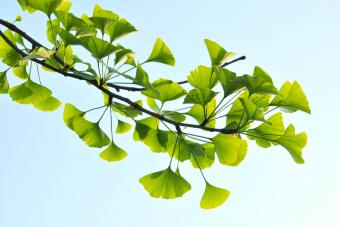
If you're looking for a gorgeous, large shade tree that's unique and also provides stunning fall color, you might want to consider a gingko biloba tree. With their fan-shaped leaves, graceful, pyramidal growth habit, and stunning bright yellow fall color, gingko is definitely a tree worth growing.
Gingko Trees in the Landscape
Ginkgo biloba are wonderful shade trees. Because they are large trees (growing up to 80 feet tall), they provide a focal point in the landscape. Dwarf cultivars are more appropriate for small urban and suburban spaces. They're often planted as street trees because of their tolerance for urban conditions.
Gingko has a medium growth rate, so planting a young tree will have an impact on your garden in a fairly short period of time. When planting gingko trees, you'll most likely want to make sure you're getting a male tree; female trees form fruits that have a not-exactly-pleasant scent.
In autumn, gingko leaves turn a stunning, bright yellow color, and then drop their leaves seemingly all at once, over the span of a day or two.
Growing Gingko Biloba Trees

Ginkgo biloba is hardy in zones 3 to 8. It grows best in full sun but also does well with partial sun.
It prefers to be planted in moist, well-drained, loamy soil, but it is very adaptable. It will grow in compacted and poor soils and withstand air pollution, salt spray, heat, and drought. This tree roots very deeply.
You can fertilize ginkgo trees once or twice a year with a balanced fertilizer.
Propagating Gingko Biloba Trees
Ginkgos can be grown from seeds, which require both scarification and stratification. Some people have an allergic reaction to the fleshy membrane around the seed, so wear rubber gloves when harvesting and cleaning the seeds. It is often impossible to determine the gender of the offspring for the first twenty years of growth.
Ginkgos are also propagated from hardwood and softwood cuttings and by grafting. This is the best way to be sure of the sex of the new tree. Most commercially-grown ginkgos are started this way.
Varieties to Grow

Cultivars of ginkgo biloba have been developed that will mature to a smaller size than the species, making it suitable for urban and suburban areas. Some popular cultivars are:
- Ginkgo biloba 'Autumn Gold,' which has golden fall color and a compact form, making it a good choice for smaller yards.
- Ginkgo biloba 'Barabits Nana' which is a dwarf variety that grows to about three and a half to four feet tall and can be grown in containers, or even as a houseplant.
- Ginkgo biloba 'Chase Manhattan' which is a compact variety, popular in bonsai or rock gardens.
- Ginkgo biloba 'Fairmount' has a narrow form and big leaves, giving it a unique look even among gingko trees. This is another good option for a smaller yard. It grows to around 40 feet tall.
- Ginkgo biloba 'Fastigiata' has a very narrow, columnar form and large leaves and grows to 30 to 50 feet tall.
- Ginkgo biloba 'Golden Globe' grows in a rounded shape and has deep golden fall color. It grows to about 40 feet tall, with a spread of around 30 feet.
- Ginkgo biloba 'Pendula' is often referred to as a "weeping" form of the gingko tree. Unfortunately, it doesn't really have that classic, graceful weeping form that many expect. It has a very wide canopy for the size of the tree, and the branches do end up slightly bending down at the tips, but it's not technically a weeping tree. Still very pretty, though, and grows to about four to eight feet tall and up to 10 feet wide.
- Ginkgo biloba 'Princeton Sentry' has a conical form and large leaves on long stems, which makes them flutter with even the slightest breeze. 'Princeton Sentry' grows to about 50 feet tall, and it's one of the fastest-growing gingko tree varieties.
- Ginkgo biloba 'Variegata' is a shrub form of gingko, with unique variegated foliage that looks green and white striped from stem to leaf edge. This is a somewhat difficult variety to find, though some specialty nurseries do carry it.
Problems and Pests
Ginkgo biloba is unusually resistant to pests, illnesses, and environmental problems. Female trees are not suitable for pedestrian areas because of their tendency to drop fruit. This tree can grow very large, so it is not suitable for small spaces, unless you find a dwarf variety.
Stunning Fall Color, Easy Care
Gingko trees are less common than other shade trees, so if you're looking for something a little different, you might want to consider planting one in your yard. Be sure to get one that will fit well in your landscape, and you'll be rewarded with beauty, as well as a tree that's relatively care-free and drought-resistant once it's established.







